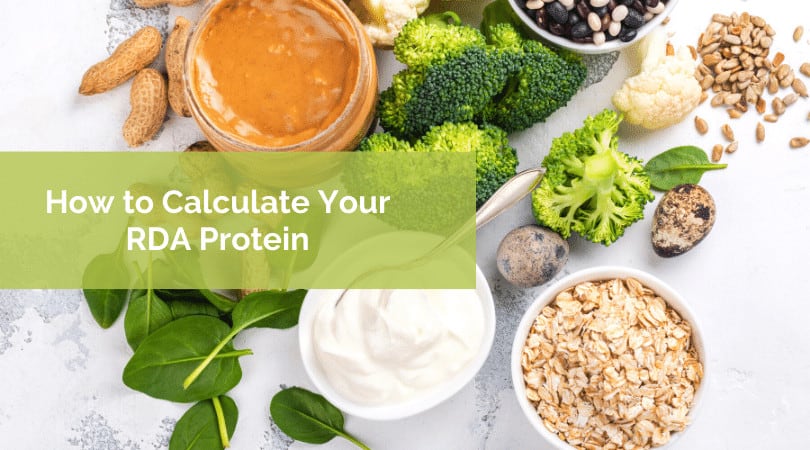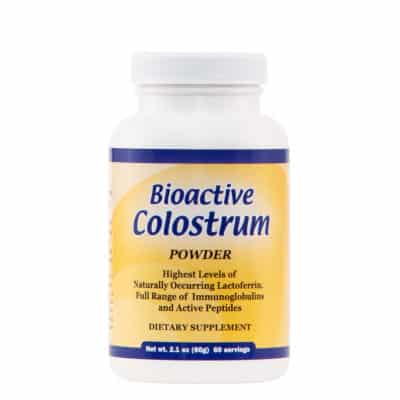
Maybe you’ve heard about the importance of protein in your daily diet, but do you know how much you are really getting and if it’s enough to meet your body’s needs?
Protein is crucial to the body’s health and daily function, but the amount you need is specific to your age, activity, and weight. This is where your Recommended Dietary Allowance (RDA) comes into play. An RDA is the average intake of a nutrient needed to meet the nutrition needs of approximately 97-98% of a healthy population.
RDAs for different nutrients have been established by the National Academy of Sciences and are intended to individualize recommendations for each essential nutrient in order to help you and your family optimize your health.
If you ever wanted to have a better idea of how much protein you should eat and how to calculate RDA for protein, you’re in luck. Follow the four simple steps outlined below to learn how to calculate your RDA for protein to ensure you’re meeting your body’s needs.
Why Is Protein So Important?
Before we get into how much protein you may need, let’s talk about why protein is important.
Protein is required by every cell in the body. Its involvement ranges from facilitating the electric current that takes place in our brain during thought, to the growth and management of muscle and bone that keeps us up and running. Functions including immunity, hormone creation, muscle strength, as well as hair and nail growth are all dependent on our ability to meet our RDAs for nutrients like protein.
Protein is a valuable nutrient for athletes and those who exercise regularly. The International Society of Sports Nutrition recognizes that protein is important for maintaining and building muscle, exercise recovery, muscle repair, and body composition. It is for these reasons that people who are physically active have higher daily protein needs, especially active individuals and athletes in endurance or intense strength-based activities.
A good helping of protein daily can also aid in weight loss. Protein is highly satiating, meaning that it will help you to feel full for a longer stretch of time. In turn, feeling full for longer will cause you to eat fewer calories and lose weight. A high-protein diet may also help increase calorie-burning by helping increase sleeping metabolic rate and increasing energy used during digestion and physical activity.
Protein is also a macronutrient that can help stabilize blood sugars. Imbalances in blood sugar can cause damage to the vascular system, disrupt normal hormone functioning, and increase risk for various health conditions. When eaten with carbohydrate-containing foods, protein foods can reduce the severity of post-meal blood sugar spikes and help with overall blood sugar control. Improved control of blood sugar also supports overall metabolic function for health and potentially weight loss.
Protein is essential for not only many day-to-day functions, but it can also help you reach your body composition goals. Some people may lose lean muscle mass while attempting to lose weight, which can impact the function of their muscles. A 2017 review of studies found that having a moderate to high protein intake (within reason) helped people who lost weight to maintain muscle mass, function, and strength.
What is the RDA for protein?
According to the 2020-2025 Dietary Guidelines for Americans, the average adult should aim to eat between 10-35% of their daily calories from protein. This is a large range that allows for flexibility in your diet depending on your lifestyle. What would this protein range look like in real life? Well, a person that needs 2000 calories a day would need to eat between 50-175 grams of protein a day. So does this mean you aim high in your protein intake? Or low? Or perhaps somewhere in between?
You may be asking yourself, how can you figure out how much protein you need? While 10-35% of daily calories is a good guideline, factors such as activity level, weight, and pregnancy can change how much protein is right for you. For example, the RDA recommendation for protein for women and the RDA for protein for men differ.
To personalize it a bit more, the US Department of Agriculture (USDA) has an easy-to-use RDA protein calculator for different ages and gender groups. This helps tailor your protein intake a bit more to meet your specific needs. If you’re looking for general guidance on what amount of protein to eat daily, the National Academy of Sciences provides the average RDAs for protein.
The average RDA for protein for specific age groups are:
- Children 1-3: 13 grams
- Children 4-8: 19 grams
- Children 9-13: 34 grams
- Girls 14-18: 46 grams
- Boys 14-18: 52 grams
- Women 19+: 46 grams
- Men 19+: 56 grams
As you can see the RDA for protein for a teenager, man, woman, or child can vary significantly.
There are of course some exceptions to these average numbers. For example, pregnant or breastfeeding women should be getting close to 60 grams or more of protein each day to support the health of the mom and growing fetus.
Individuals with a vigorous fitness regimen will often require a higher dose of protein. In addition, if you have certain medical conditions, such as kidney disease or cancer, it is important to talk with your healthcare providers about the right amount of protein for you.
One thing to note about the RDA is that it is meant to represent the amount of protein needed to support day-to-day functions and prevent muscle wasting. It is not the amount of protein you need if you are an athlete, an older adult, want to lose weight or are in a period of growth.
Depending on your situation, simply following the RDA without regard to your life stage or lifecycle could actually put you at risk of not getting enough protein daily. This is why protein needs should be calculated to your specific lifestyle and goals.
How to Calculate RDA for Protein
The averages discussed above are meant to provide general guidance, but for information tailored to you, it is a good idea to learn how to calculate RDA for protein for adults. If this seems overwhelming, consider speaking to a registered dietitian who can help you figure out how much protein you need. A dietitian can also counsel you on how to integrate more protein-containing foods into your diet.
If you’re up to the challenge of learning how to calculate your personal RDA protein recommendations, then we have the tools you need in order to easily calculate those needs.
For adults over the age of 19, in order to calculate RDA for protein, follow these four quick steps:
- First, step on the scale. To get an accurate number, weigh yourself in the morning with an empty bladder. If you don’t have a scale, it is okay to use a recent weight from an appointment, such as a doctor’s visit.
- Next, you will need to convert your weight from pounds to kilograms. There are 2.2 pounds per kilogram, so simply divide your weight in pounds by 2.2. If you want to use pounds to calculate your RDA for protein? Skip ahead to Step 4 for the calculation using pounds.
(weight in pounds) / 2.2 = weight in kilograms
- Now that you have your weight in kilograms, you can easily calculate your RDA. Simply multiply your weight in kilograms by 0.8 to arrive at your daily protein recommendation.
(weight in kilograms) x 0.8 = RDA for protein (g/day)
- Using pounds to calculate your RDA for protein:
(weight in pounds) x 0.36 = RDA for protein (g/day)
If you’d like to calculate your RDA for protein but want the help of an online tool, give this online RDA protein calculator a try.
Remember that a calculator will not give you a complete picture, it will only give you the baseline of what you need. If you are routinely exercising, strength training, or are trying to lose weight, you may need more protein than your RDA indicates.
It is also important to keep in mind that protein goals should support lean body mass needs. Therefore, if you have been told or are aware that your Body Mass Index (BMI) or general body weight are above what is simplistically considered a “healthy weight range”, using an “Ideal Body Weight” may be more appropriate when calculating out protein goals. Ask your healthcare team or follow the steps below for guidance if you need help calculating your Ideal Body weight.
Ideal Body Weight (Using Hamwi Formula)
Women:
IBW= 100 lbs for the first 5 feet in height + 5 lbs. for each inch over 5 feet.
Ex. A female with a height of 5 foot 5 has an IBW of 125 lbs. [100 lbs for first 5 feet + 25 lbs for the additional 5 inches (5 inches x 5 lbs = additional 25 lbs)]
Men:
IBW= 106 lbs for the first 5 feet in height + 6 lbs. for each inch over 5 feet.
Ex. A male with a height of 5 foot 5 has an IBW of 136 lbs. [106 lb for first 5 feet + 30 lbs for the additional 5 inches (5 inches x 6 lbs = additional 30 lbs)]
How to Get Enough Protein
It is easy to hit your daily RDA recommendation for protein by eating high-protein foods at meals and snacks. Contrary to popular nutrition myths, eating a high-protein diet does not require eating meat all the time. There are many protein-rich plant-based foods out there to choose from, so even if you aren’t a big meat eater, it shouldn’t be too difficult to hit your RDA for protein.
To help you along, here are some protein-filled foods to incorporate into your meal planning:
- Beef
- Lamb
- Poultry
- Milk and yogurt
- Fish
- Eggs
- Beans
- Nuts/seeds
- Cheese
- Tofu
- Protein powder/supplements
As you can see, protein is found in a variety of different plant and animal foods. Eating a variety of high-protein plant and animal foods can help you effortlessly meet your RDA for protein. Aim to eat a high protein food at every meal to keep you full and fueled.
Putting it All Together: Meeting your RDA for Protein
Once you’ve calculated your RDA for protein, make a point to pay closer attention to nutrition labels when purchasing food. Compare the protein amount in grams of the foods you eat on a regular basis to see if you have been meeting your RDA recommendation for protein or if you should increase the amount of protein in your diet.
While eating enough protein may seem difficult at first, remember that this is the amount of protein you need over the course of an entire day. Including a protein source at each meal and snack can help this feel manageable.
If you need an example of how to eat a high-protein diet, here’s how you would plan your day. For example, a woman weighing 65 kilograms (or 143 pounds) needs 52 grams of protein per day. If she eats 15 grams of protein at all three meals, which is only about 2 ounces of meat, and has an afternoon snack with 7 grams of protein, like a cup of yogurt, she has met her RDA for protein! It really doesn’t take that much food to meet your RDA daily.
If you are still unsure how to go about meeting your protein needs, here are some examples of the protein content in some everyday foods to help you determine how much protein you are actually ingesting. Mix and match foods from this list to meet your daily needs.
- 1 cup of milk—8 grams of protein
- 3-ounce piece of meat, chicken, or fish—21 grams of protein
- 1 cup of dry beans—16 grams of protein
- 8-ounces of yogurt—11 grams of protein
- ½ cup legumes- 7 grams of protein
- ¼ cup mixed nuts- 7 grams of protein
- 1/2 cup of tofu—10 grams of protein
- Whey protein powder– 16 grams of protein per scoop
Keeping a record of the high-protein foods you eat daily can help you keep track of your protein intake. You can create a food journal, write in a food log, use a meal and fitness tracker, or simply keep some informal notes to check in with your protein intake.
By looking at your diet and how much protein you are eating every day, you may even discover that you have been hitting your RDA for protein without even trying.
So now that you know the importance of protein and are equipped with the tools to calculate your own unique protein recommended daily allowance, you can make a conscious effort to stick close to the number when you plan out your meals.
An easy rule of thumb to get started is to simply eat a type of high-protein food at every meal and snack. Doing this will help you effortlessly reach your daily protein needs.
Of course, your RDA for protein is simply an average number that you should aim for. Even if you don’t hit your goal every day, you can still live healthily even if you eat more or less protein on some days. Meeting your daily protein needs will help you fuel your cells and muscles, so you can live the healthy life you want.
FAQ
How to calculate how much protein I need?
To calculate how much protein you need daily, first get a recent and accurate measure of your body weight. If your weight is in kilograms, multiply your weight by 0.8 to calculate how many grams of protein you need daily. For weight measurements in pounds, multiply your weight by 0.36 to calculate your daily protein needs.
How much protein do you really need?
Generally speaking, the National Academy for Sciences recommends that the average, healthy person get 0.8 g of protein/kg or 0.36 g of protein/lb. Your individual protein needs may differ due to your age, gender, level of activity, health status, and pregnancy status.
Why is the RDA for protein important?
Protein is vital for the normal functioning of your body – growth, hormone production, immunity, muscle building and strength, and everyday cellular functions require protein and amino acids. Without adequate protein intake, your body cannot function to its optimal levels. The RDA for protein is an important guideline that can help you get enough protein to stay healthy and perform at your best.
References:
- Jäger R, Kerksick CM, Campbell BI, et al. International Society of Sports Nutrition Position Stand: protein and exercise. J Int Soc Sports Nutr. 2017;14:20. Published 2017 Jun 20. doi:10.1186/s12970-017-0177-8
- Azzout-Marniche D, Gaudichon C, Tomé D. Dietary protein and blood glucose control. Curr Opin Clin Nutr Metab Care. 2014;17(4):349-354. doi:10.1097/MCO.0000000000000062
- Cava E, Yeat NC, Mittendorfer B. Preserving Healthy Muscle during Weight Loss. Adv Nutr. 2017;8(3):511-519. Published 2017 May 15. doi:10.3945/an.116.014506
- 2020-2025 Dietary Guidelines. Accessed June 15, 2022. https://www.dietaryguidelines.gov/
- DRI Calculator for Healthcare Professionals. Accessed June 2, 2021. https://www.nal.usda.gov/fnic/dri-calculator/
- Kominiarek MA, Rajan P. Nutrition Recommendations in Pregnancy and Lactation. Med Clin North Am. 2016;100(6):1199-1215.
- IBW equation using Hamwi Method. Accessed June 28, 2022. https://www.eatrightpro.org/news-center/nutrition-trends/nutrition-assessment/adjusted-or-ideal-body-weight-for-nutrition-assessment
- Should You Take Whey Protein Powder After Surgery? - March 2, 2023
- How Much Protein is Too Much? - January 30, 2023
- Is Whey Protein Keto Friendly? - January 30, 2023




